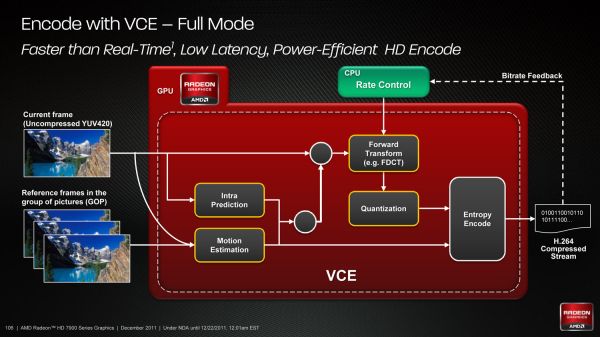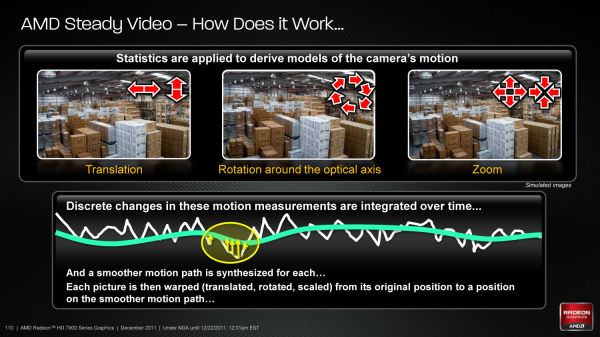AMD Radeon HD 7970 Review: 28nm And Graphics Core Next, Together As One
by Ryan Smith on December 22, 2011 12:00 AM EST- Posted in
- GPUs
- AMD
- Radeon
- ATI
- Radeon HD 7000
Video & Movies: The Video Codec Engine, UVD3, & Steady Video 2.0
When Intel introduced the Sandy Bridge architecture one of their big additions was Quick Sync, their name for their hardware H.264 encoder. By combining a specialized fixed function encoder with some GPU-based processing Intel was able to create a small, highly efficient H.264 encoder that had quality that was as good as or better than AMD and NVIDIA’s GPU based encoders that at the same time was 2x to 4x faster and consumed a fraction of the power. Quick Sync made real-time H.264 encoding practical on even low-power devices, and made GPU encoding redundant at the time. AMD of course isn’t one to sit idle, and they have been hard at work at their own implementation of that technology: the Video Codec Engine (VCE).
The introduction of VCE brings up a very interesting point for discussing the organization of AMD. As both a CPU and a GPU company the line between the two divisions and their technologies often blurs, and Fusion has practically made this mandatory. When AMD wants to implement a feature, is it a GPU feature, a CPU feature, or perhaps it’s both? Intel implemented Quick Sync as a CPU company, but does that mean hardware H.264 encoders are a CPU feature? AMD says no. Hardware H.264 encoders are a GPU feature.
As such VCE is being added to the mix from the GPU side, meaning it shows up first here on the Southern Islands series. Fundamentally VCE is very similar to Quick Sync – it’s based on what you can accomplish with the addition of a fixed function encoder – but AMD takes the concept much further to take full advantage of what the compute side of GCN can do. In “Full Mode” VCE behaves exactly like Quick Sync, in which virtually every step of the H.264 encoding process is handled by fixed function hardware. Just like Quick Sync Full Mode is fast and energy efficient. But it doesn’t make significant use of the rest of the GPU.
Hybrid Mode is where AMD takes things a step further, by throwing the compute resources of the GPU back into the mix. In Hybrid Mode only Entropy Encode is handled by fixed function hardware (this being a highly serial process that was ill suited to a GPU) with all the other steps being handled by the flexible hardware of the GPU. The end goal of Hybrid Mode is that as these other steps are well suited to being done on a GPU, Hybrid Mode will be much faster than even the highly optimized fixed function hardware of Full Mode. Full Mode is already faster than real time – Hybrid Mode should be faster yet.
With VCE AMD is also targeting Quick Sync’s weaknesses regardless of the mode used. Quick Sync has limited tuning capabilities which impacts the quality of the resulting encode. AMD is going to offer more tuning capabilities to allow for a wider range of compression quality. We don’t expect that it will be up to the quality standards of X264 and other pure-software encoders that can generate archival quality encodes, but if AMD is right it should be closer to archival quality than Quick Sync was.
The catch right now is that VCE is so new that we can’t test it. The hardware is there and we’re told it works, but the software support for it is lacking as none of AMD’s partners have added support for it yet. On the positive side this means we’ll be able to test it in-depth once the software is ready as opposed to quickly testing it in time for this review, however the downside is that we cannot comment on the speed or quality at this time. Though with the 7970 not launching until next year, there’s time for software support to be worked out before the first Southern Islands card ever goes on sale.
Moving on, while encoding has been significantly overhauled decoding will remain largely the same. AMD doesn’t refer to the Universal Video Decoder on Tahiti as UVD3, but the specifications match UVD3 as we’ve seen on Cayman so we believe it to be the same decoder. The quality may have been slightly improved as AMD is telling us they’ve scored 200 on HQV 2.0 – the last time we scored them they were at 197 – but HQV is a partially subjective benchmark.
Finally, with Southern Islands AMD is introducing Steady Video 2.0, thesuccessor to Steady Video that was introduced with the Llano APU last year. Steady Video 2.0 adds support for interlaced and letter/pillar boxed content, along with a general increase in the effectiveness of the steadying effect. What makes this particularly interesting is that Steady Video implements a new GCN architecture instruction, Quad Sum of Absolute Differences (QSAD), which combines regular SAD operations with alignment operations into a single instruction. As a result AMD can now execute SADs at a much higher rate so long as they can be organized into QSADs, which is one of the principle reasons that AMD was able to improve Steady Video as it’s a SAD-heavy operation. QSAD extends to more than just Steady Video (AMD noted that it’s also good for other image analysis operations), but Steady Video is going to be the premiere use for it.












292 Comments
View All Comments
CeriseCogburn - Sunday, March 11, 2012 - link
We'll have to see if amd "magically changes that number and informs Anand it was wrong like they did concerning their failed recent cpu.... LOLThat's a whole YEAR of lying to everyone trying to make their cpu look better than it's actual fail, and Anand shamefully chose to announce the number change "with no explanation given by amd"... -
That's why you should be cautious - we might find out the transistor count is really 33% different a year from now.
piroroadkill - Thursday, December 22, 2011 - link
Only disappointing if you:a) ignored the entire review
b) looked at only the chart for noise
c) have brain damage
Finally - Thursday, December 22, 2011 - link
In Eyefinity setups the new generation shines: http://tinyurl.com/bu3wb5cwicko - Thursday, December 22, 2011 - link
I think the price is disappointing. Everything else is nice though.CeriseCogburn - Sunday, March 11, 2012 - link
The drivers suckRussianSensation - Thursday, December 22, 2011 - link
Not necessarily. The other possibility is that being 37% better on average at 1080P (from this Review) over HD6970 for $320 more than an HD6950 2GB that can unlock into a 6970 just isn't impressive enough. That should be d).piroroadkill - Friday, December 23, 2011 - link
Well, I of course have a 6950 2GB that unlocked, so as far as I'm concerned, that has been THE choice since the launch of the 6950, and still is today.But you have to ignore cost at launch, it's always high.
CeriseCogburn - Thursday, March 8, 2012 - link
I agree RS, as these amd people are constantly screaming price percentage increase vs performance increase... yet suddenly applying the exact combo they use as a weapon against Nvidia to themselves is forbidden, frowned upon, discounted, and called unfair....Worse yet, according to the same its' all Nvidia's fault now - that amd is overpriced through the roof...LOL - I have to laugh.
Also, the image quality page in the review was so biased toward amd that I thought I was going to puke.
Amd is geven credit for a "perfect algorythm" that this very website has often and for quite some time declared makes absolutely no real world difference in games - and in fact, this very reviewer admitted the 1+ year long amd failure in this area as soon as they released "the fix" - yet argued everyone else was wrong for the prior year.
The same thing appears here.
Today we find out the GTX580 nvidia card has much superior anti-shimmering than all prior amd cards, and that finally, the 7000 high end driver has addressed the terrible amd shimmering....
Worse yet, the decrepit amd low quality impaired screens are allowed in every bench, with the 10% amd performance cheat this very site outlined them merely stated we hope Nvidia doesn't so this too - then allowed it, since that year plus ago...
In the case of all the above, I certainly hope the high end 797x cards aren't CHEATING LIKE HECK still.
For cripe sakes, get the AA stuff going, stop the 10% IQ cheating, and get our bullet physics or pay for PhysX, and stabilize the drivers .... I am sick of seeing praise for cheating and failures - if they are (amd) so great let's GET IT UP TO EQUIVALENCY !
Wow I'm so mad I don't have a 7970 as supply is short and I want to believe in amd for once... FOR THE LOVE OF GOD DID THEY GET IT RIGHT THIS TIME ?!!?
slayernine - Thursday, December 22, 2011 - link
Holy fan boys batman!This comment thread reeks of nvidia fans green with jealousy
Hauk - Thursday, December 22, 2011 - link
LOL, Wreckage first!Love him or hate him, he's got style..